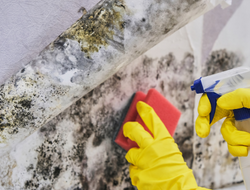
Mold can be a very problematic and costly nuisance in your home. The difficulties mold brings can impact both your home structurally and cause health problems to your loved ones. Mold is an organic substance in the fungus category and just like any organism, its main function is to survive. While there is an abundance of mold that we interact with everyday outside of our homes, the problems begin when mold decides to be a guest in our homes.
Where does mold come from?
Mold has always been present in our world. It has some good use for us, and it’s not always just an in-home pest. Without mold, natural elements like trees, leaves and other organic materials would never decompose, even after they die. When mold begins to grow on and consume these natural materials, it releases mycotoxins (which are airborne) that humans can breathe and, sometimes, can be toxic if enough is inhaled over a period of time. Luckily there is enough air and circulation outside typically to prevent us from serious reactions.
However, when mold enters our homes where there is limited airflow, then it can become hazardous. The #1-way mold gets into a home is from water, which carries bacteria. Water can enter from a broken pipe, leak or even from high humidity. In the right environment, mold will linger and grow until there is no more food source. There are thousands of species of mold, each releasing different types of mycotoxins – known for causing skin/eye irritation, upper respiratory tract symptoms, asthma symptoms, and cognitive impairment. While babies and elderly are more prone to developing these symptoms, depending on the mold, it can affect anyone if enough is present for an extended period of time.
I think my home has mold. What do I do now?
If you suspect your home has mold, your first step is to hire a licensed Mold Inspector or Mold Hygienist to test your home. The Mold Hygienist will take samples either by swabbing visible potential mold or take air spore (mycotoxins) samples of the areas of the home you believe are affected. The samples are then sent to a lab which will determine the type of mold and how many spores are present in the home. If an elevated amount of mold is present or determined hazardous, then a mold remediation plan will be written for how to remove the mold from the environment – which should be performed by a licensed mold remediation company. In some states it is a requirement to have testing performed before any mold can be removed.
Mold Maintenance Tips
Once water enters your home, mold can start breeding within 48 hours. Consider the following clean-up techniques if mold ever finds its way into your home:
- Protect Yourself – Before any mold clean-up, make sure you protect yourself by using gloves, masks, and eye protection.
- Drying – Drying is the best way to prevent future mold growth and to keep materials structurally sound. Keep air circulating by using fans (only if you do not see mold, as fans could spread mold further), dehumidifiers, and keeping doors and windows open.
- Cleaning – Use water and a detergent to remove all visible mold, and dry immediately after cleaning. Remember to not mix cleaning products together, as it could create toxic vapors.
- Disposal – Throw away items or materials that cannot be dried or cleaned.
To guarantee you’re removing all the mold in your home the right way, your best bet is to hire a license home restoration or mitigation company to provide proper drying tools and removal steps.
Additionally, be sure to ask your insurance agent or broker if you have mold coverage under your homeowners policy.
Austin Walsh is a Property Risk Consultant for Chubb Personal Risk Services.
The opinions and positions expressed are the authors’ own and not those of Chubb. The information and/ or data provided herein is for informational purposes only and is not a substitute for professional advice. Insurance coverage is subject to the language of the policies as issued.